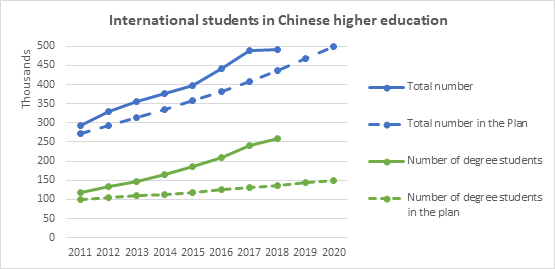China’s 2020 target: reshaping global mobility flows

With the Chinese New Year on our doorsteps, the Year of the Rat is also the year in which the Chinese Ministry of Education aims to reach the milestone of half a million international students studying in Chinese higher education institutions. How is China tracking for this target, what does it mean for Chinese higher education, and what will the ripple effects be for Europe and the rest of the world?
In September 2010, the Chinese Ministry of Education launched the Study in China plan, which aimed to increase the international student population in China. The goal is that in 2020 China will host 500,000 international students (including 150,000 degree students).
It seems clear that the Chinese mobility target of 500,000 international students will be reached by the end of 2020, if one compares the number of actual enrolled international students in Chinese higher education to the forecast in the Study in China plan (see chart below). According to the most recent statistics by the Ministry of Education, the total number of international students in Chinese higher education was 492,185 (including 258,122 degree students) in 2018. China has overtaken the UK (hosting 458,520 international students in 2018 according to Study in UK) to become the host of second largest international student population, after the USA (which hosts around one million international students).

Source: Statistics of International students in China 2011-2018, Ministry of Education of the People’s Republic of China. Chart by Yuzhuo Cai.
What’s in it for China?
Beyond statistics, many people wonder what China has gained from hosting half a million international students. However, there seems to be no definite answer to this question yet, partly due to a lack of research on the impacts of increasing international students in China.
China has overtaken the UK to become the host of second largest international student population, after the USA
Currently the most visible feedback on the phenomenon is possibly that of the Chinese media. Although China’s media outlets are set up to promote positive images of society, they have increasingly shown doubt and criticism of China’s policy of attracting international students, criticising the overwhelming benefits for international students in China and arguing that this inbound mobility has challenged the principle of equity in education. Many people also question why the Chinese government has spent so many public funds on international students. Due to the increasing criticism from the Chinese media, in July 2019, the Ministry made an official statement explaining the expenditure of public funds on international students. However, it was not only about money, but also the overall academic quality of international students a concern for people.
Nevertheless, there are also positive anecdotes on the benefits to China from hosting half a million international students. The reported benefits were mainly aligned with the OECD’s expectations from attracting international students, like revenue generation, skilled migration, capacity building and mutual understanding.
International education as diplomacy
Most positive opinions cite the idea of “increasing mutual understanding”. This is also related to China’s aspiration of building its soft power underlined by Xi Jinping’s strategy of the Chinese Dream. The international alumni of Chinese universities are expected to potentially facilitate China’s international cooperation and its race to distribute influence, values and ideologies to other states. To such end, it largely depends on what images of China are conveyed by international students to their home countries. Unfortunately, no studies have been done to investigate this aspect of the policy. The few studies that have been conducted on international students’ experience in China seem to indicate a negative view concerning universities’ service and the compatibility of Chinese education with international standards and the social environment. These sentiments may undermine the implementation of China’s soft power strategy through educating international students.
Instead of encouraging international students to stay and work there, China seems more eager to attract talents with a foreign university degree
Global experience suggests that recruiting international students is also a means for attracting global talents to the local labour market, thus supporting national or regional economic development. In China’s case, however, it seems unclear whether this has been taking place. Instead of encouraging international students with Chinese university degrees to stay and work in China, China seems more eager to attract those talents with a foreign university degree to come and work in China. China’s illusion of its international students is based on the idea that they return to their home countries after graduation and become the “ambassadors” to convey the image of China. Thus it has neglected the potential benefits of drawing on its educated international student population to bolster the labour market inside China.
What’s next?
Hong Kong University Professor Yang Rui has argued that China’s higher education reform, including the international education dimension, is underpinned by the ‘catching up’ mentality. Will China set a new target of hosting one million international students to compete with the US? We don't know that yet.
What seems clear is that, in contrast with the US and the UK’s recent shifts in the opposite direction, China is taking its steps firmly towards globalisation. It has become a large international education market and an important international partner for Europe, and it will play an active role in global leadership. According to China’s Education Modernisation 2035 plan, released in 2019, the Study in China plan will continue, with the focus shifting from quantity to quality. As 75.52% international students are from Asia and Africa, China will make more efforts to attract students from the other regions, such as Europe.
Moreover, China will extend its global reach through opening more overseas campuses, following the pioneering efforts, such as the Xiamen University Campus in Malaysia established in 2017 and Peking University’s UK Campus opened in 2018. Although attracting foreign students to China and opening up university branches around the world are primarily for building up China’s soft-power capacities, it also contributes to globalisation of higher education and particularly provides opportunities for European universities to better engage and collaborate with their Chinese counterparts. European-Chinese university collaboration can also strengthen networks and build trust for cooperation on science, technology and innovation.






